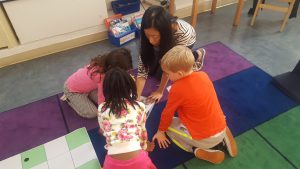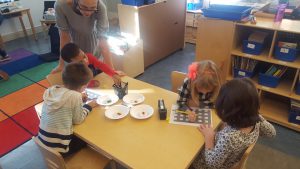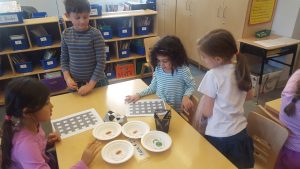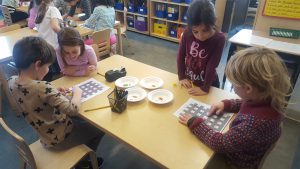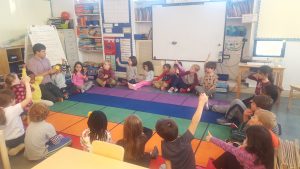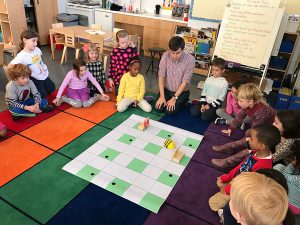Adventures of the First Grade BeeBot
The first grade’s traditional neighborhood study and “block city” took a giant leap into the 21st century with a collaborative STREAM project. Introduced last year, the sophomore version of the study has been refined and enhanced and student learning is soaring.

“Marshmallowville”, 1B’s traditional Block City
A S.T.R.E.A.M. (Science, Technology, Research, Engineering, Art, and Math) project was integrated into the first grade neighborhood social studies unit. This collaborative experience was taught by all of the first grade classroom teachers (Jill, Natania, Elizabeth, Alyssa, Lara, Laura, and Henna), Jonathan (K-2 math specialist), Susan (art), Gili & Kathy (PS/LS librarians), and Tracy (LS technology).
Students first worked with their classroom teachers to learn about their neighbourhoods by studying the needs and wants of a community, the buildings that serve a community, and the wonderful diversity that exists within our very own neighbourhoods!
First graders extended this learning experience by engaging in a task to build a neighborhood called “Friendsville” for a robot bee called “BeeBot”. In art, students thought about the buildings that should exist in a community for BeeBot and designed their buildings using collage paper with Susan.

“Friendsville”, a neighborhood for the BeeBot
In math, students learned about geometry through their block building project and directionality by giving specific instructions to “Robot Jonathan”, so that he could move through the classroom.
In our first combined math and technology class, the first graders were introduced to BeeBot and to the use of computational thinking strategies to help create or code a program to navigate BeeBot in Friendsville from one building to another. We learned about the importance of decomposing big problems into smaller problems and giving specific and ordered instructions (algorithms). We also discovered that we need to give instructions for movement based on the perspective of the BeeBot.
During library classes, Gili & Kathy introduced the book Hello Ruby by Linda Liukas in their study of the non-fiction sections of the library. Students learned more about how to use the various computational thinking strategies when solving problems.
In the second math and technology class, students reviewed their first BeeBot programs to find ways to optimize their code. Students discovered that when commands repeat, the use of loops can make our code simpler and more efficient.
Finally, students got to test out their BeeBots, using both the BeeBot app and the actual BeeBot!
To watch the videos of BeeBot’s trips across Friendsville, please email jmartin@brooklynfriends.org


